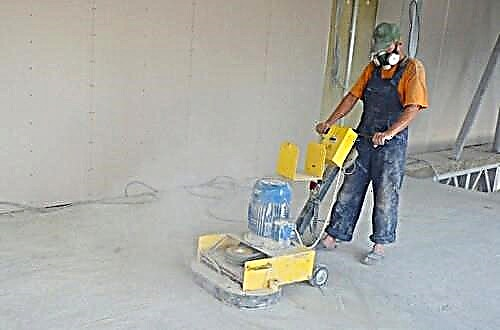JAPANESE BATHS
Japanese bath: eastern exotic in the Russian manner.
The traditions of each country are unique and distinctive in their own way. They are an essential part of culture and reflect the mentality of a particular nation. Acquaintance with traditions may seem a curiosity for a newcomer, but this only increases interest in a foreign culture. For example, a Russian bathhouse with hot air, birch brooms and diving into an ice hole shocking foreigners who first encountered this phenomenon. But for the Europeans, a Japanese bathhouse will seem like a real exotic. At the first visit to a Japanese bath, it is difficult to imagine not only the process of bath procedures, but also the purpose of fonts of unusual shape. However, having visited and tried it once, you will certainly want to experience this bliss again and, possibly, organize a Japanese bathhouse at your own site or in a private house.
Japanese baths can be of three types: FURAKO, OFURO and SENTO - different contents with the same content. Having come to a Japanese bath for the first time, the average European is likely to be disappointed. No steam rooms, washing and familiar bath paraphernalia - only a large wooden barrel with water, next - a bathtub with warm sawdust or pebbles and a couch in the corner. What kind of bathhouse is this? Indeed, Japanese baths are quite specific in their appearance and content: there is no familiar stove, benches and other related attributes and, rather, they do not resemble a bath in the direct sense of the word, but a large bath. However, the Japanese way of taking such a “bath” gives it the ability to heal and even rejuvenate the human body. Here everyone will be able to get the maximum of pleasant sensations and derive invaluable benefits for the body.
The first two varieties: furaco and ofuro are used at home or as small private baths, designed to receive 1-2 visitors. A completely different thing is sento - a public bath, where more than 100 people can take procedures at the same time. A specialty of sento is the obligatory sequence of procedures - visitors to the bath are pre-washed in a separate room and only after that they go to the hot water pool. Sento is often visited by the whole family.
However, despite the difference in names and appearance, all Japanese baths have one philosophy and one meaning. And it is this: the therapeutic effect here is obtained not from high humidity or high air temperature, but from hot water or heated sawdust (in some cases, pebbles). In general, from what it is possible to fill a diving tank, which is the central element of any Japanese bath.
Japanese baths are now often an integral part of large SPA-centers. Here, in addition to the traditional procedures provided for in the national Japanese bath, it is possible to order additional services - cosmetic masks, body wraps, massages, etc.
You can choose and buy Japanese baths FURAKO or OFURO on our website: https://fenix-ural.tiu.ru
You can also get detailed information and place an order:
by phone / Viber: 8 951 818 60 87
by e-mail: [email protected]
At the request of the buyer, delivery to any region of Russia and the Republic of Kazakhstan is possible.
What is it - Japanese bath
The Japanese bath is a spacious room with good ventilation and fresh air. There are no steam rooms, sinks, brooms and other bath paraphernalia. Instead, a large wooden container, called the furaco, and a couch for relaxation are installed in the room.
The main purpose of the Japanese bath is the ability to relax the body and mind, relax from worries and tune in to appeasement.
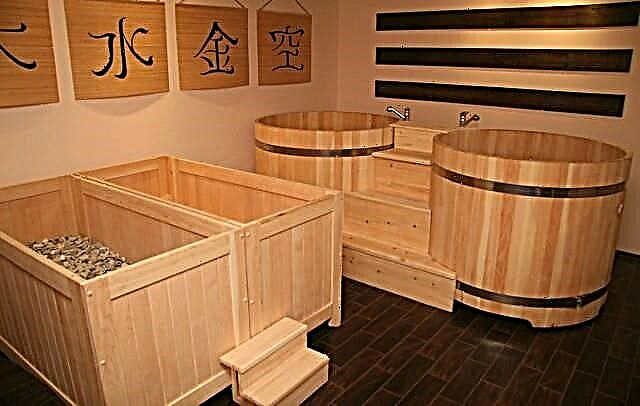
Features baths in Japan
The Japanese sauna is fundamentally different in that it uses not hot steam or air, as in the vast majority of baths and saunas, but heated water. The prerequisites for the appearance of such hygienic procedures are the following factors:
- The predominant religion in Japan is Buddhism, which forbade the use of soap, because at that time it was made from the adipose tissue of dead animals. But it is impossible to wash away impurities from the skin without soap, so they began to use hotter water. For an unusual European, the water temperature in a Japanese sauna is almost unbearable.
- Religious views prohibited the wearing of clothes made of wool and fur. Light cotton fabrics are not able to warm the body.
- Climatic conditions in the Japanese islands are quite severe. It is always wet and damp, and in winter temperatures drop below 0 ° C. Traditional dwellings always had thin walls, and it was cold in them. To keep warm and not get sick from hypothermia, we used such a peculiar Japanese sauna in the form of a container with hot water.
- Since ancient times, the Japanese used thermal springs for these purposes, of which a large number in the country. But not everyone could freely get there, because they were not always located close to home. As an alternative, a barrel of very hot water was used.
Now the Japanese are using various cosmetics and this kind of bath is more of a health nature, since it strengthens the immune system, tempers the body, improves metabolic processes, increases efficiency and improves mood.
The sequence of procedures in the Japanese bath
In Japanese bathing traditions, the sequence of procedures is extremely important. Each step should have a corresponding effect, without which it is impossible to proceed with the following steps.
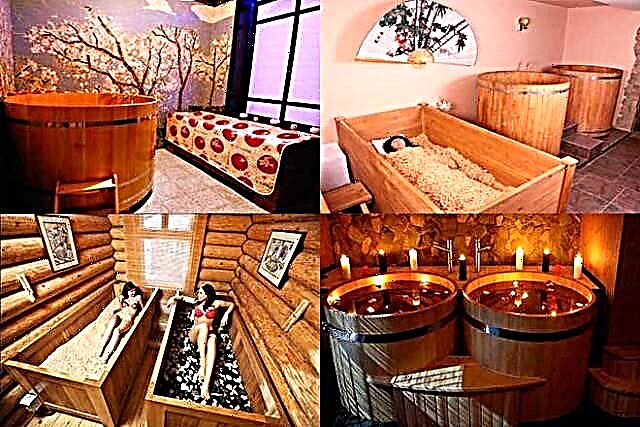
In a Japanese bath, you must go through the following steps in sequence:
- Visit the shower.
- Steam and warm your feet in a special bath.
- Then a foot massage is performed. This stage is preparatory. During the massage, biologically active points are activated, of which there are a large number on the feet. The result of this procedure is the corresponding mood for relaxation and relaxation.
- Immerse yourself in a chest in a furaco barrel filled with water at a temperature of + 35 ... + 45 ° C for 10-15 minutes. Warm water should not reach the line of the heart, because it will cause unnecessary stress and poor health.
- Get out of the barrel, wrap yourself in a towel and lie down on the couch to relax.
- Now begin to take dry baths. First they are immersed in ofuro - a container filled with sawdust warmed up to + 45 ... + 50 ° C for 10-15 minutes.
- Once again, a shower is taken to wash away the remnants of sawdust.
- Then comes the ofuro with stones, which are heated to + 50 ... + 60 ° C.
- The final and final stage is the tea ceremony.

For swimming in Japan, special barrels and bathtubs made of coniferous wood are used.
Japanese bath furaco
The key attribute of the Japanese bath is the furaco barrel, which is a large round (sometimes oval) container made of valuable wood (cedar, oak, etc.). The tank is equipped with an oven for heating water. Furaco home options are equipped with gas or electric stoves. For a street barrel, a wood stove is more suitable. Traditional Japanese baths have always been heated with wood.

The Japanese barrel bath is internally divided by a trellised wooden partition. In one compartment, a bathing procedure is carried out, the other is designed to accommodate a heating device. In some designs, this device may be outside. The ablution compartment is equipped with a wooden bench around the perimeter for convenient location of visitors. Furaco font with a stove can accommodate from 2 to 8 people.
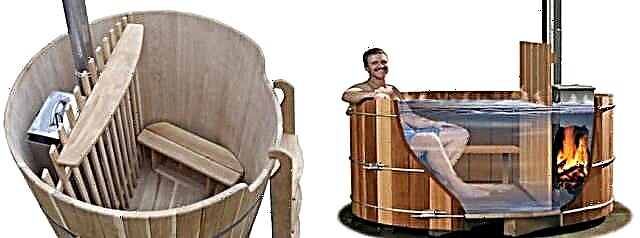
Water is heated to + 35 ... + 45 ° C, to enhance the beneficial healing effect, incense, aromatic oils, herbal decoctions and infusions, flower petals, etc. are added to it. The material of the barrel from which it is made releases phytoncides into hot water. These substances positively affect the human body, providing tonic and restorative effects.
The beneficial effects of the Japanese furaco barrel are as follows:
- with sweat secretions, a large number of toxins and harmful toxins are removed from the body,
- metabolic processes and the functioning of the immune system are stimulated,
- the condition of the skin improves, the pores open,
- normal activity of the heart and blood vessels,
- helps in the prevention and treatment of diseases of the genitourinary sphere, musculoskeletal system and respiratory diseases.
The design of the Japanese bath-barrel provides a lid, which closes it in the absence of visitors and to protect against unwanted debris (in the street version).

Japanese bath ofuro
Japanese bath can be made in the form of a rectangular box. For manufacturing, specially treated cedar, teak, ash or oak wood is used. Such a container has thick walls and is equipped with a heating system, which is located in its bottom. Heating systems are equipped with various additional options - thermostat, remote control, etc. The size of the box can be different, it depends on the number of people that fit in it. More often than not, such a bath is intended for one visitor. He lays in her at full height.

Ofuro's font is filled with sawdust (larch, cedar, linden, oak) mixed with dry leaves, medicinal herbs (over 60 species), roots and aromatic essential oils. The mixture is heated to + 45 ... + 50 ° C. The weight of sawdust is about 45-50 kg, the top layer (about 2 kg) is removed and updated after each visit to the bath.
They are immersed in a sawdust bath around the neck and are there for no more than 30 minutes. During this time, the skin is well warmed up. Intensive sweating begins, during which toxins are released from the body. Sweat is immediately absorbed by sawdust.
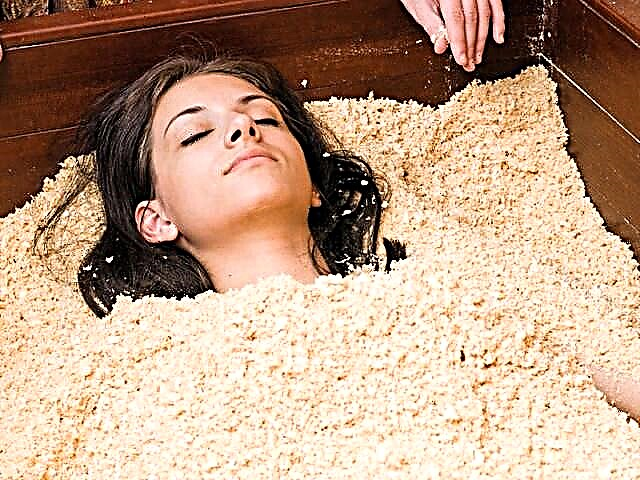
At the same time, the heated sawdust itself releases useful oils and volatile substances that have a healing effect on the skin (destroy microbes and bacteria, heal wounds, relieve irritation, etc.). Aromatic components activate metabolic processes, slow down aging. Ofuro bath is considered the best way to rejuvenate and lose weight.

After visiting the bath with sawdust, it is supposed to undergo a similar procedure in a box with dry pebbles preheated to 60 ° C, covered with a sheet or towel. They are laid on her back and lie for 10-15 minutes. You can lie on your stomach, in this case, additional heated stones are placed on the back along the spine. There are options ofuri ofuro in volcanic ash.
Sento Japanese Bath
Japanese public baths sento are very popular. Such a bath is a fairly spacious and well-ventilated room, which houses a roomy, but shallow pool with hot water (+ 50 ... + 55 ° C). The sizes of the pool are different, sometimes it can accommodate up to 100 people. In sento there are always 2 departments: female and male. The rooms for women are more spacious, and they have many mirrors.

First, they remove all clothing in a room equipped with separate booths. After you should thoroughly wash your body using various hygiene products (soap, shampoos, washcloths, etc.). A special washing room is intended for this. They wash themselves under the tap, sitting on a low bench. In Japanese traditions, it is customary to wash using a contrast shower.
Only then can you immerse yourself in the hot water of the pool. The time spent in the pool is no more than 10-15 minutes, longer staying there is already harmful to the body. The Japanese bath has special relaxation rooms where you can lie down after taking hot procedures. Tea drinking is the traditional completion of the bath ceremony.
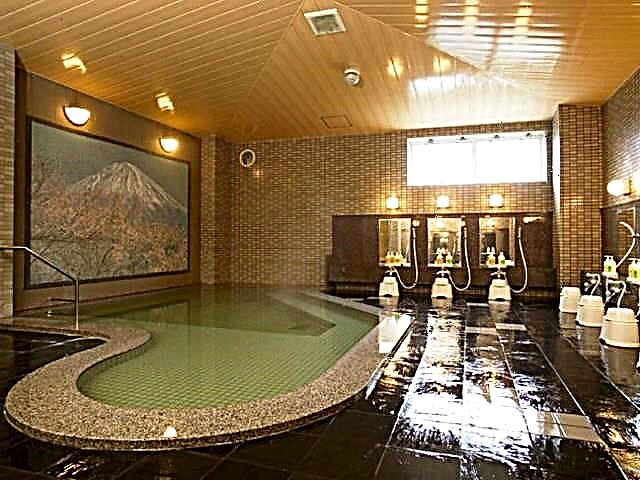
Initially, sento baths were intended and built only for priests, they looked quite unpresentable and ascetic. But gradually the baths became available to the rest of the population. The rooms began to be decorated with murals on the walls (waterfalls, volcanoes, blooming sakura, etc.), which were conducive to contemplation and reflection.
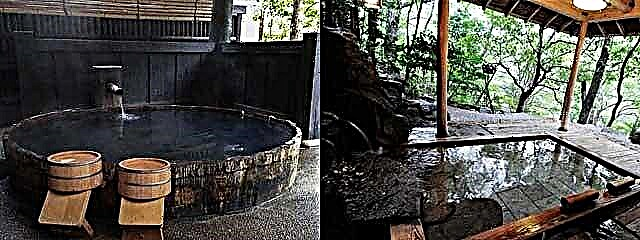
Contraindications to visiting the Japanese steam room
Despite the positive effect, the Japanese sauna is not suitable for everyone. The following contraindications exist for the bath:
- pregnancy,
- age restrictions (at least 3 years old),
- colds and infectious diseases in the active stage,
- severe chronic diseases during exacerbation,
- oncology, epilepsy, tuberculosis,
- individual intolerance.
Japanese bathing traditions are rapidly gaining popularity and are widely distributed in many countries of the world. Most large spas offer similar services, and in order to visit the Japanese bath, you do not have to fly to the Land of the Rising Sun.
Features of the Japanese bath
The first associations in a Russian person associated with a bath were the high temperature in the room and the presence of steam with a broom. But in the Japanese bath there is no hot air, no familiar birch broom, no stove stove, which is so used to splashing hot water. Everything is different here, except for one - the goals of bath procedures. And they, as you know, are the same in all baths - healing, purification, pleasure of soul and body.
The main feature in the Japanese bath is the presence of warm water procedures plus a kind of "dry bath" (we will talk about them below). Ofuro Japanese bathhouse is a kind of large wooden font made of cedar, larch or oak. It constantly maintains a water temperature of 40-45 degrees. Indoors, electric heaters are used to heat water, and a small wood-burning stove is provided for street-style fashionable fonts.
Ofuro sizes are different. Somewhere capacities are applied only for one person, and somewhere for a large company. For greater convenience, a bench is installed around the perimeter of such a bathtub. At the same time, a person can comfortably sit down and relax. The level of warm water should not exceed the chest level of a sedentary person.

This is an important condition and should be observed. Otherwise, the heart of a person taking such a bath will experience additional unnecessary loads. The healing effect of such a bath will be minimal, and in some rare cases the opposite.
A wooden barrel is installed in a spacious cool room, where there is a constant influx of fresh air. There are also couches for relaxation. The Japanese bath also has a shower and as a mandatory attribute - a room for tea ceremonies. The whole sauna meal takes place in a strictly defined sequence, which cannot be violated in any way. After all, the Japanese people have developed these traditions for centuries.
Procedures in the Japanese bath and their sequence
Following the instructions of distant ancestors, all procedures in the Japanese bath begin with the preparation of a mental attitude, as well as with warming up and massage of the feet of both legs. As you know, a person has a great many biologically active points on his feet. Thanks to the preparatory massage, almost all internal organs of the human body are affected. It creates a kind of mental attitude for relaxation and relaxation.
Then they take a shower and go directly to the warm water procedures.Being chest deep in warm water, the body relaxes perfectly and gets a deeper warm-up compared to hot air exposure. The time spent in such a font is 10-15 minutes. This is quite enough to "get to the right condition." To diversify, embellish and increase the healing properties, rose petals or other aromatic additives are added to the water.
Coming out of the warm font, they wrap themselves in a sheet and lay down to rest on the couch. After a short rest and complete drying of the body, they begin to take the so-called dry baths - furaco. Furaco are large wooden crates made for a lying man. They lack water, and there is a filler that also warms the body and has a healing effect. The so-called dry steaming of the body occurs.
In one of the boxes are dry cedar sawdust, often there are added fees of various herbs (chamomile, mint, oregano, etc.). Cedar is generally a “magic tree”. No wonder the Japanese use it for such interesting recreational purposes. Sawdust from below is heated to 45-50 degrees, as they are the heaters and heat carriers.
A person lays down in such a bath with sawdust and falls asleep with them. The body feels a warm, light and pleasant tingling sensation. The skin begins to absorb all the healing properties of cedar and herbs. And the sawdust at the same time take away with it all the slag and unnecessary salts. Dry steaming in a Japanese bath lasts 10-15 minutes. A man during this time manages to warm up well and relax.
After such an “exotic procedure”, a shower is taken again. And there comes a time of executions with stones. Instead of sawdust, the second furaco is filled with sea pebbles. These stones also warm up, but already up to 50-60 degrees. A person lays down on them with their stomachs, and individual specimens can fit on the spine and lower back. Thus, the human body is already heated with stones, not sawdust. At this time, a light massage will not be superfluous, since the effect of it at the moment is simply wonderful.
At the end of heating on stones, a final and important stage follows. This is a tea ceremony. It uses only green tea. It is much better than black, restores the loss of water from the body. It should be clarified that all actions in the Japanese bath are slow and relaxed. By tradition, there is always an assistant in the bathhouse - a geisha who provides massage and assists in all activities.
Useful properties of the Japanese bath
Since the Japanese bath carries out heating of the body in various ways (water, sawdust, stones), then the healing effect of such complex procedures is very noticeable. We can say that under milder and not familiar conditions, a person receives the same therapeutic result as from higher-temperature brethren. A similar example can be given with the Turkish hammam. There are also no hot and "harsh" conditions, as in a Finnish sauna or a Russian bath.
So, what kind of positive therapeutic results does the Japanese ofuro give? Here is some of them:
- Excellent joint prophylaxis and treatment
- Improving blood circulation and heart function
- Increased immunity and overall body tone
- Rejuvenation and improvement of the skin
- Excellent stimulation of all internal organs
- Metabolism is normalized and excess weight is eliminated
- Stress Relief, Nerve Calming and Sleep Recovery
From the above it becomes clear why the Japanese ofuro bath is gaining more and more popularity. Today, many reputable SPA salons are opening that offer the services of such an exotic bath. And ordinary citizens who want to install a similar design at home can buy a rectangular bathtub or a wooden model equipped with a stove in stores. Of course, the full stage of a real Japanese bath with sawdust and stones in it you will not spend, but warm water procedures will bring a lot of pleasure.
Quote of wisdom: Not success, but effort deserves a reward.
The main types and differences of the Japanese bath
Japanese baths, in principle, differ from the species we know, and, visiting it for the first time, many may experience disappointment without noticing the steam rooms and other attributes familiar to the Russian or European visitor. The only thing that will attract attention is a large barrel, a wooden sunbed and several obscure containers with stones or sawdust. Nevertheless, it is a special ritual associated with ancient national traditions and filled with exalted philosophical meaning.
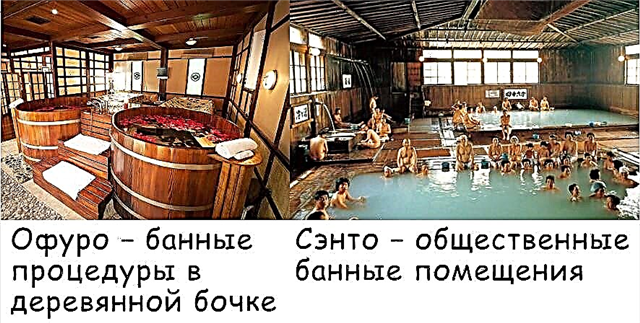
Japanese bath - types
Having different names and differing in appearance, the Japanese baths have one thing in common - the cleansing and healing effect does not come from heated air and high humidity, but from water brought to high temperatures, and hot stones (pebbles) or sawdust. The Japanese believe that this method of adoption "Bath", brings the greatest benefit to the body and body, and also completely rejuvenates and restores vital functions.

If we take into account the statistics, then Japan is one of the leading places in the ranking of centenarians, so the last maxim looks quite logical.
A bit of history
For many centuries, such a concept as a bath, in our understanding, did not exist among the Japanese. Of course, this does not mean that they did not observe hygiene and were "Dirty people", just questions regarding body cleanliness were resolved a little differently. According to religious concepts characteristic of Buddhism, the use of soap was considered unacceptable, since it was associated with the killing of animals. The rubbing of dirt was effectively controlled using wood ash and rice husk.

Japanese Bath - Ofuro
After a kind of peeling, the Japanese plunged into a large tub of hot water, where they steamed their body and engaged in meditation. Thus, in the summer they got rid of sweat and dust, and in winter this kind of procedure was an excellent method of protection against hypothermia and the prevention of all kinds of diseases, because skins and fur coats were also alien to the beliefs of the faith. The constant bathing in such barrels has become part of the national culture, which today is the pride and peculiarity of Japan.
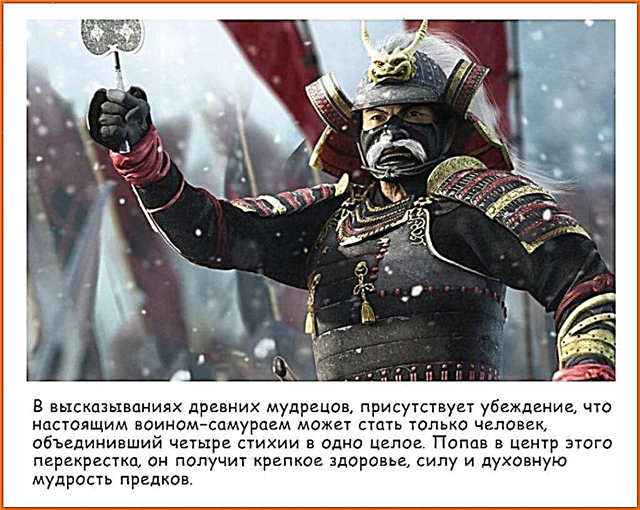
Japanese Bath - History
The Japanese bathhouse is a kind of model of the sacred sacrament, embodying fire, air, water and land, so the Japanese with reverent respect for their ofuro and sento, considering them the best gift.
The device and the basic rules of the Japanese bath
Ofuro - This is a whole complex of Japanese bathing procedures. And it begins with a visit to the shower. Then you will be offered to plunge into furaco. It is a wooden barrel (mainly cedar or oak), divided into two unequal sections.

For starters, it may seem too hot, but after adaptation, the body and body get used to and enjoy the process. In some baths there are two or three of them with a gradual increase in degrees.
In order for swimming in furaco not turn into troubles, there are several general recommendations:
- Before taking the basic procedure, you must definitely wash yourself in the shower and tune in to relaxation,
- sitting in a tub is necessary so that hot water does not reach the area of the heart, since when immersed, the load on the cardiovascular apparatus increases,
- You can stay in the tank for no more than 15 minutes, this time is enough for a healing effect,
- after the procedure, it is better to relax and drink tea with lemon,
- to get the most tangible result, you can add decoctions of herbs, aromatic oils or sea salt to the water.
After water baths, when the body has steamed well, you need to wipe yourself dry and go to the next stage of obtaining pleasure - dry procedures.

After such a bath session, you must definitely drink green tea and relax.
Bani Santo
The Japanese are very fond of visiting sento - public bath rooms, where they go families and large companies. In ancient times, large baths for 4-5 people made of wood filled with hot water were installed in such saunas.

After swimming, here you can relax in special rooms in the style of the Japanese garden, decorated with flowers, small trees and equipped with aquariums.
Benefit and harm
The positive effect of the Japanese bath on the human body, no doubt. But the heavy loads associated with high temperatures make it necessary to treat it, however, like other similar institutions, extremely carefully. If you have any health problems before visiting, the advice of your doctor is extremely necessary.

Ofuro also contributes to:
- Improving blood circulation, stimulates the work of the heart and blood vessels
- Strengthening immunity and preventing colds
- Accelerate the metabolism, which contributes to active weight loss
- Pain Relief for Joint Diseases
- Normalization of the kidneys, biliary tract, liver, relieves swelling, removes excess fluid
- Skin tightening and rejuvenation
- Improvement of the respiratory system
So, if health allows and you want to try something new in bathing pleasure, you can taste the delights of the Japanese national bathhouse. Moreover, you do not need to visit Japan for this. In modern large cities, the number of institutions offering this type of service is growing every year, and in a fairly wide price range.
So, if you wish, you can always find entertainment affordable, and in extreme cases, and with a great desire, it is quite possible to arrange a Japanese bath at home. Indeed, to equip a small bathhouse you need much less space and money than for a Russian steam room, Finnish sauna or Turkish hammam.


